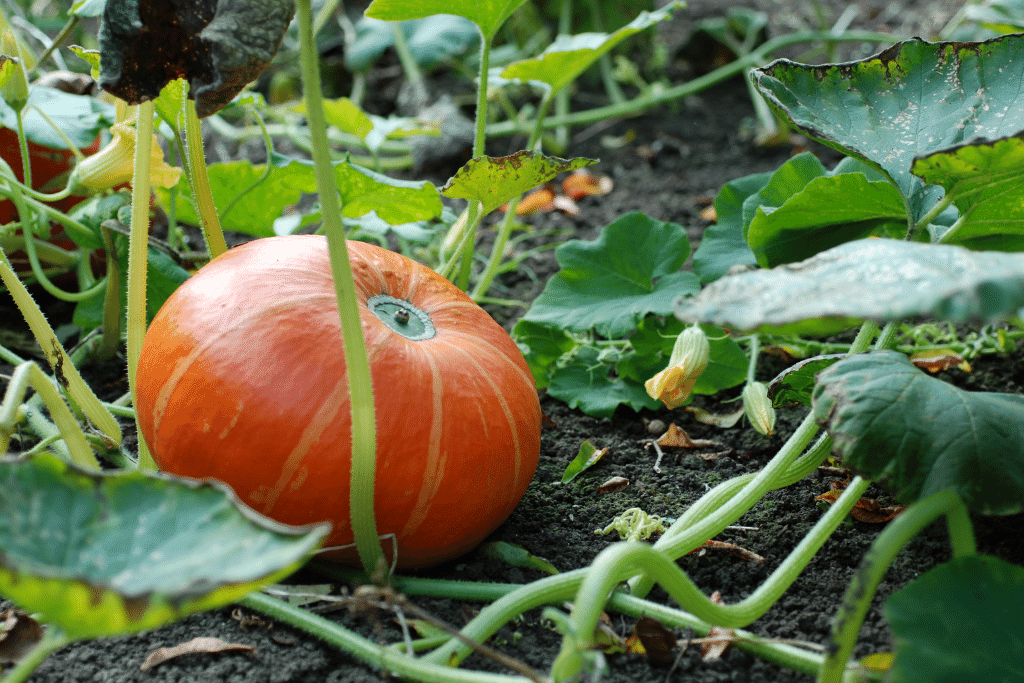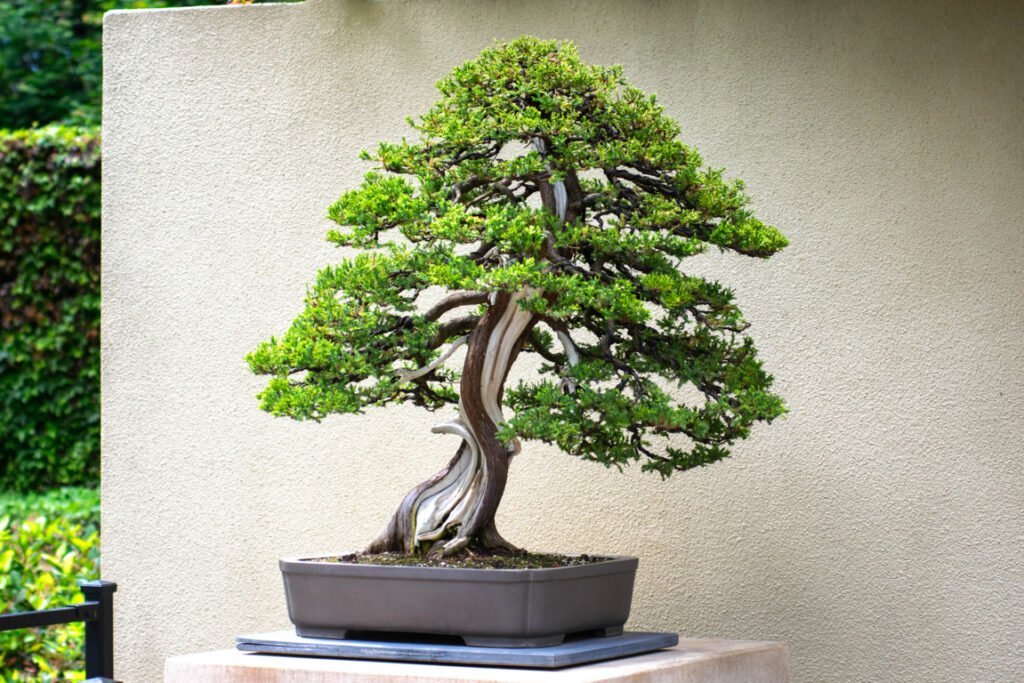Dying orchids usually show a few signs to let you know; the browning or yellowing of leaves or a mushy crown. There can be several reasons your orchid is dying, but it’s typically pretty easy to identify the specific cause. If you’re unsure and asking, ‘why is my orchid dying?’, read on and diagnose it!
There are different species of orchids which may have different care requirements, so it’s important to note that before you buy an orchid, you should research its specific care requirements. If you cannot provide it with those conditions, it might be worth getting a different species or a completely different plant.
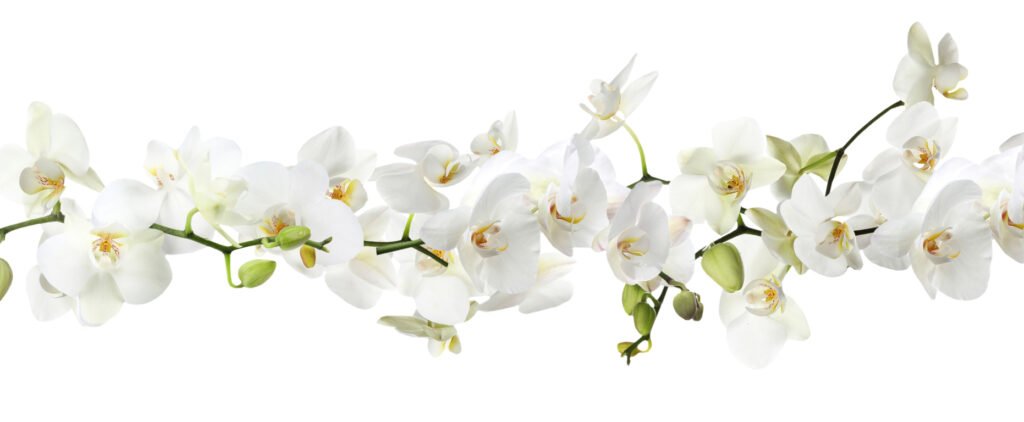
Why Is My Orchid Dying?
Reason 1) Overwatering
Unlike other plants, orchids don’t need to be watered that frequently – I only water mine once a week. Watering more often than this, or every day will kill your orchid. The orchid will develop root rot, turning the leaves yellow and limp. Some more common signs of root rot are when the roots begin to emit an unpleasant smell and turn rotten.
Even though orchids should not be overwatered, this doesn’t mean that you shouldn’t water them thoroughly when doing it. Giving orchids a tiny drop of water once a week will lead to underwatering, which will also kill your orchid. It’s best to water them thoroughly – I usually let mine sit in water for around 10 minutes before removing them from it.
Recovery
If you believe you have overwatered your orchid, it’s still possible to recover it. Identifying that you are overwatering, and you should reduce your watering. Let the soil medium dry out slightly before watering – you can test the soil’s moisture by poking your finger an inch deep into the medium.
Any brown or rotten roots should be removed with a sterile pair of pruners, preventing the spread of fungal disease to uninfected parts of the plant. You can then plant it back in a potting medium with good drainage, such as a combination of pine bark-based compost.
Reason 2) Underwatering
Even though orchids may not like to be too damp at times, it’s essential that they are watered at least once a week. Without this, their leaves will wilt and turn brown or yellow, usually a severe sign of underwatering.
To prevent underwatering your orchid, you can poke your finger an inch deep into the soil to check if there’s moisture. If the medium seems completely dry, you should thoroughly water it.
Your orchid should be watered around every seven days in summer and spring. They should be watered around every 7-10 days in autumn and winter. Plants go dormant in winter, using up less energy, and therefore they have a reduced water demand.
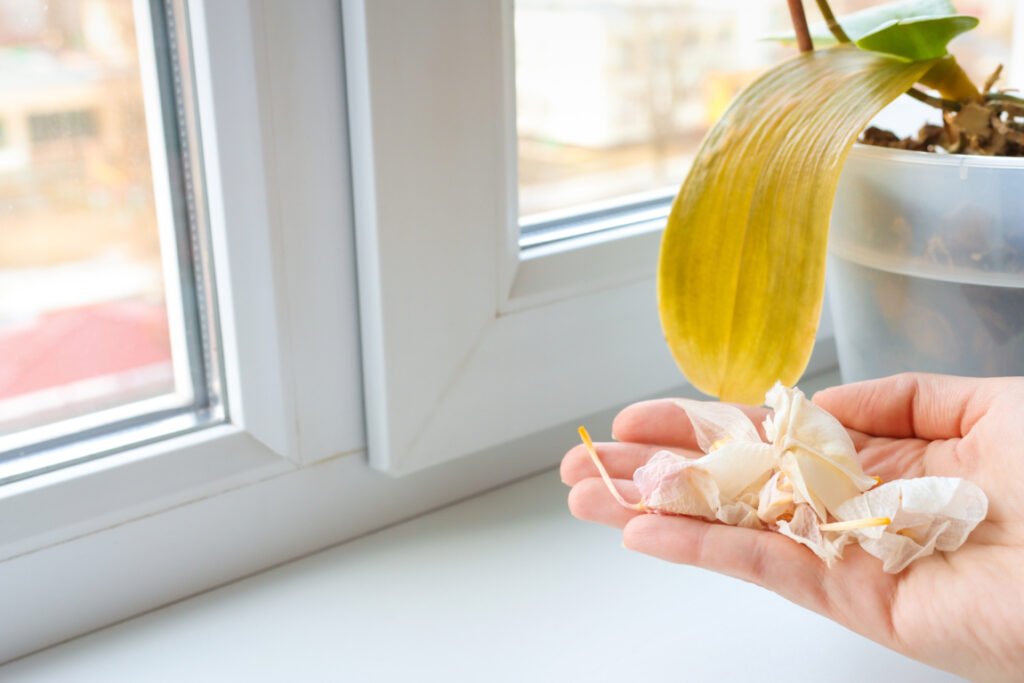
Tips to Prevent Underwatering
- Water thoroughly! – Many growers tend only to give their orchids minimal water, thinking they’ll drown it if they give it too much. This isn’t optimal, and when we water our orchids, we should water them thoroughly. This ensures that a good amount of water reaches the roots, allowing the soil medium to retain enough for the next few days until the next watering. Watering thoroughly can also help revive any roots that have shrivelled due to underwatering, preventing the orchid from using up any moisture reserves.
- Mist your orchids – Around every three days, you should mist your orchid. This will help it to recover if you have underwatered it while also helping them put on more growth and thrive indoors. This will increase the humidity around them, benefiting them!
- Give it the correct temperature – By keeping orchids in positions that get too hot, the soil’s moisture will evaporate a lot quicker, meaning that you’ll have to keep on top of your watering schedule frequently. This will also mean that your orchid may experience drought stress, which can stress it out and kill its roots. They should be kept below 23 degrees in the daytime and around 13 degrees at night.
Depending on how badly your orchid has been underwatered, you might experience the loss of leaves or yellowing/browning of leaves. This is a normal thing to happen; however, with enough luck and care, your orchid should regrow these in the spring/summer!
Reason 3) Low Humidity
In their natural habitats, orchids live in quite tropical climates. Therefore, when we keep orchids inside, we should provide enough humidity to thrive. We must aim to emulate the tropical climate’s conditions, but not to the point where our house becomes a swamp!
Orchids kept in a low-humidity environment will have water sapped from the leaves, which may result in the death of the orchid. A good majority of orchids kept by people are ‘Moth’ orchids, also known as Phalaenopsis orchids. These mainly live in tropical climates, so it’s advised to give them a high humidity level. Some species may require lower humidity levels, so you should research before buying!
Symptoms to look out for include the dropping of flower buds. Flower buds can take up quite a bit of energy for plants to develop, so it’s expected that when a lot of flowering plants get stressed, they drop their flowers.
If you’ve noticed this, try moving your orchid to a position in your house with higher humidity levels, or begin misting your orchid frequently. It may be worth investing in a hygrometer to measure the humidity around your orchid!
Reason 4) Insufficient Light
As I mentioned before, orchids are adapted to live in tropical climates. These tropical forests usually have large and dominant trees spanning the sky with their great branches and mighty trunks, so orchids have adapted to this. The leaves of an orchid can be pretty sensitive to light, so if we don’t give them enough light (or too much), this can lead to the leaf yellowing or becoming brown. When I first got my moth orchid, I was quite surprised to learn this and asked myself why is my moth orchid dying?
If your orchid is in direct sunlight and getting scorched, it might be worth moving it to a position where it receives fewer hours of sunlight per day or moving it to indirect light throughout the day.
Symptoms of orchids not receiving enough light include the lack of flowers. When an orchid is stressed, it won’t put out as many flowers as usual, which is particularly noticeable if it typically put out a mass of flowers each year! Growth may also be stunted, so it’s essential to note how much growth your healthy orchids are putting on to realize when they are suffering.
To ensure your orchid isn’t suffering from too much light or not enough, it’s best to keep orchids in a place with indirect sunlight or filtered light, preventing direct sunlight from hitting the leaves and scorching them. With this in mind, you should also note that they still need enough sunlight – many people place them in unsuitable places around the house, such as bathrooms, where they might not get enough light.
If you believe your orchid has already suffered from this, you should move them to a position with filtered or indirect light and water them thoroughly once a week, misting them. This will help them to recover, and hopefully, they will be able to put out growth in the spring/summer.
Reason 5) Temperature
Unfortunately, orchids can be pretty picky with the conditions they require! One such condition is temperature. Sudden drops in temperature or prolonged exposure to unsuitable temperatures can stress an orchid out.
Symptoms include the orchid stopping growth, flowers falling off or leaves turning yellow. The orchid may start to droop slowly, indicating that it’s pretty stressed out.
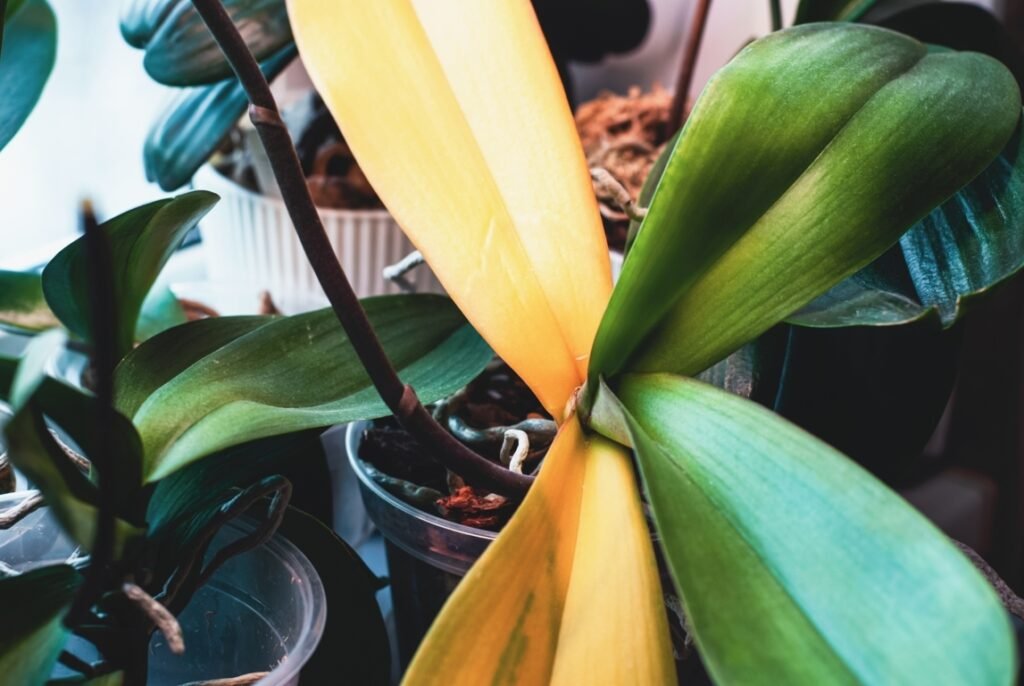
One issue I see a lot is people confused as to why their orchid on a windowsill kept at a stable temperature is dying – surprisingly, it’s the window! Orchids which come into contact with a cold window frame can cause the leaves to be brown or yellow – and this also applies to them being too close to a source of heat in your home, such as a radiator (they’ll start to drop their flowers).
While I keep my orchids on windowsills, I ensure they have enough clearance from the window, so they’re not directly touching it. I have a spare room which I use for orchids, and I can maintain the temperature and humidity levels, so this might be worth considering if you want to get serious about orchids!
Reason 6) Crown Rot
When the leaves of an orchid grow, they can form a funnel shape around the stems, collecting water over time which prevents drainage. This can cause crown rot, turning the leaves yellow or causing them to wilt.
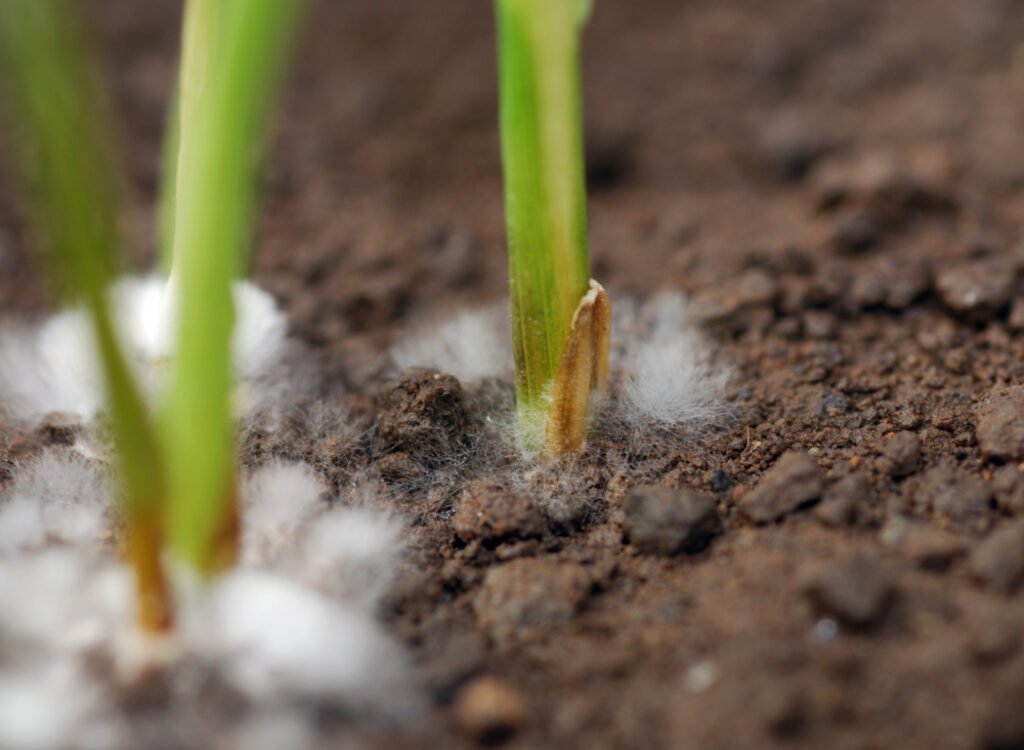
In nature, moth orchids (Phalaenopsis) grow on trees at a 45-degree angle, allowing water to drain easily from them, preventing rot. Therefore, when watering your orchid, a simple way to avoid crown rot is to water the potting medium, not overhead from the leaves.
Try to avoid getting water on the leaves as much as possible – if I do get any on the leaves, then I like to rub it off with something, such as a paper towel, to make sure that it doesn’t rot the crown.
If you think your orchid might suffer from crown rot, it’s treatable but not as easy as other reasons. Fungal pathogens are responsible for crown rot; the pathogen can spread to other parts of the problem, so you’ll have to monitor your orchid.
To treat the orchid, you should buy a bottle of hydrogen peroxide. After this, you can pour a small amount onto the crown of the orchid, repeating for around 2-3 days. You should be able to see some bubbling occurring – repeat until you don’t see this anymore. It’s recommended that you also sprinkle some cinnamon on the crown after, as cinnamon acts as a natural fungicide. Who knew?
Reason 7) No Fertilizer or Overfertilizing
It can be tricky to find a balance between the two sometimes, but with enough experience, you should know when to fertilize your plants. It’s very beneficial to feed your plants regularly in the growing season, as it’ll allow them to put on more growth and help in the development of flower buds on orchids.
When buying fertilizer, you should pay attention to the NPK (Nitrogen, Phosphorous, Potassium) ratios. Nitrogen will drive growth in the orchid, phosphorous will help in the development of flower buds, and potassium will help with the general movement of water and nutrients around your orchid. It’s important to find a balanced fertilizer that suits your orchid; why not try different ones?
You can usually find specific fertilizers for orchids which I recommend – as you know, they’ll be safe to use on your orchid and designed for orchid use. Some other fertilizers may contain higher amounts of NPK, which could burn the roots of an orchid.
If you believe you have overfertilized your orchid, you should remove as much fertilizer from the roots as possible. You can do this by leaving the orchid in a tub of water for around 10-20 minutes, allowing the fertilizer to drain from the roots. If the root burn is severe, you may have to prune off any dead roots and move the orchid into a medium that doesn’t contain excess fertilizer.
Key Information
From this article, you should have been able to diagnose the problem your orchid is suffering from; or learn new knowledge which will help you identify if you’re doing something wrong. If you’re still unsure, you could do a google search with your specific symptoms, ask your friends or family or ask on a forum! Orchids can be pretty demanding plants, especially for beginners, so you might likely kill a few before you get the hang of it – don’t be discouraged.
Frequently Asked Questions (FAQ)
Can you bring a dead orchid back to life?
You can bring your orchid back to life depending on how severe the symptoms are. If it’s severely underwatered, try submerging it in water for around 10 minutes to soak the root mass thoroughly. However, after a certain point, you won’t be able to revive an orchid. I like to check on my orchids regularly, checking for any problem signs and ensuring they thrive in their environment.
What are the signs of a dead orchid?
Common signs that your orchid has died include faded or blotchy yellow leaves and mushy roots. The leaves may also drop, which can be quite a bad sign for your orchid. Typically, combinations of symptoms will occur when your orchid is dying, so it’s important to note them and look at specific causes, such as underwatering, to diagnose your orchid.
How do I know if I have overwatered my orchid?
Overwatered orchids usually have a few signs that accompany overwatering. Their leaves may look limp or leathery, and they may begin to turn yellow. Leaves changing color in orchids is usually a common sign that something is wrong.
Should I remove dead leaves?
If you notice that your leaves have begun to blacken or brown, it’s best to prune them off. This will prevent it from spreading to other parts of the plant, especially if it’s a pathogen causing it. You can do this with a sharp pair of pruners; however, you need to make sure that you sterilize them before making any other cuts with the pruners. You don’t want to spread the pathogen to your other orchids or plants, so it’s always best to sterilize them with something such as rubbing alcohol.


